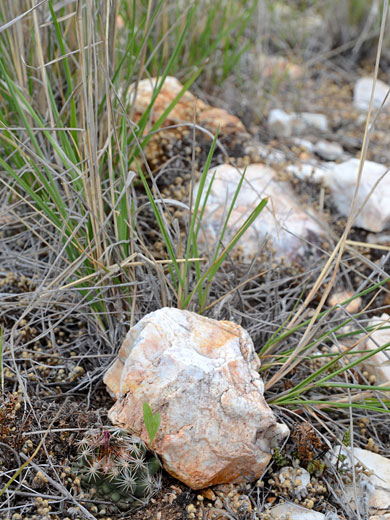Scientific name:
Escobaria hesteri, coryphantha hesteri, escobaria vivipara var deserti
Common name:
Hester pincushion cactus
Range:
Brewster and Terrell counties, west Texas
Form:
Small globes or cylinders; often unbranched, eventually forming clusters
Habitat:
Grassland, oak and pinyon-juniper woodland
Flowers:
Bright pink, with fringed outer tepals. Blooms April to June

Distribution map for escobaria hesteri
Escobaria hesteri, or coryphantha hesteri, is a rare species, of conservation concern, found in a small area of west Texas, in the Big Bend region though not within the national park, instead in two locations a little north, around Sanderson in Terrell county, and the Marathon Basin in adjacent Brewster county. Plants inhabit grassland, light woodland and rocky places, on volcanic, sandstone or limestone soils, between 3,600 and 5,300 feet elevation.
Plants are usually solitary but can form dense clusters. The dull green stems are small, less than an inch across, with pronounced tubercles, grooved on the upper surface. Stems are often partly buried below ground, especially during dry periods. Spines number between 13 and 20, (usually) all radial, white or pale yellow though becoming gray when old, and darker at the tips. Spines are somewhat unequal in length; the longest (at the top of the tubercle) around half an inch, and they do not obscure the stem.
Flowers, around one inch across, form near the tip of the stems in late spring. Tepals are bright pink, sometimes purplish, paler towards the tip, and those around the outside are fringed. Anthers are yellow-orange, the stigma lobes pale pink to white. The egg-shaped fruits are green, around a quarter of an inch long, usually with withered petals persisting.
Plants are usually solitary but can form dense clusters. The dull green stems are small, less than an inch across, with pronounced tubercles, grooved on the upper surface. Stems are often partly buried below ground, especially during dry periods. Spines number between 13 and 20, (usually) all radial, white or pale yellow though becoming gray when old, and darker at the tips. Spines are somewhat unequal in length; the longest (at the top of the tubercle) around half an inch, and they do not obscure the stem.
Flowers, around one inch across, form near the tip of the stems in late spring. Tepals are bright pink, sometimes purplish, paler towards the tip, and those around the outside are fringed. Anthers are yellow-orange, the stigma lobes pale pink to white. The egg-shaped fruits are green, around a quarter of an inch long, usually with withered petals persisting.
All Contents © Copyright The American Southwest | Comments and Questions | Contribute | Affiliate Marketing Disclosure | Site Map


